« May 2008 | Main | July 2008 »
June 29, 2008
Coffee Break

Bette Davis in Mr. Skeffington (Vincent Sherman - 1944)
Posted by Peter Nellhaus at 12:30 AM | Comments (2)
June 28, 2008
A Lustful Man
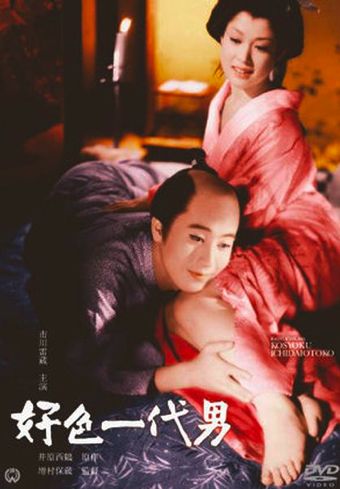
Koshoku Ichidai Otoko
Yasuzo Masumura - 1961
Kadakawa Video Region 3 DVD
Seeing A Lustful Man reminded me of a literature teacher who's favorite adjective was "picaresque". Of the films I've seen by Yasuzo Masumura, A Lustful Man may not have the fevered nuttiness of Blind Beast or even Giants and Toys, but still finds the filmmaker in a teasing mood. While the story is about a man whose guiding principle seems to be "cherchez la femme", Masumura also undercuts any romantic notions of life in old Japan with the oft expressed statement that being a samurai is stupid.
Raizo Ichikawa portrays Yonosuke, a young man for whom the only reason to live is to make women happy. In addition to bedding as many as possible, he evens spends money, albeit not his own, to free a geisha so she can be with the man she loves. The film is episodic, literally jumping from place to place courtesy of the map that appears between scenes. Yonosuke's generally cheerful outlook is contrasted against the misery of virtually everyone else whether samurai, merchant or peasant.

While he did not see A Lustful Man, Jonathan Rosenbaum's essay gives an idea of how the film fits in with Masumura's other work. Most of the characters Yonosuke runs into are the down and out, the losers of society. There are even a couple of glimpses into gay Japan as when Yonosuke stumbles into a brothel populated by transvestite prostitutes, and during a brief lock up in prison, another prisoner suggests that they sleep together. The women are considered for most of the men to be commodities to be bought, sold, kept or tossed aside. Yonosuke appears to love women for their own sake and not not simply out of his own sexual needs. The film may be interpreted as a critique of materialism as almost every activity is based on the exchange of money. Yonosuke's father is introduced picking up a grain of rice and explaining that his wealth was in part established by his frugality.
On the surface, A Lustful Man may seem to be similar to Truffaut's The Man who Loved Women or some of the films of Fellini, Masumura's former teacher. Masumura keeps Yonosuke's fantasies in the head of his character, while constantly reminding us of the uncompromising realities of the world he lives in. This may also be part of the novel A Lustful Man is based on, but Yonosuke remains constantly optimistic no matter what situation he's in, a samurai era Candide. There is humor to be found in situations such as Yonosuke escaping from a Buddhist monastery only to find a pretty nun alone in a hut. Thinking he is going to seduce the nun, the tables are turned when the woman reveals she is a prostitute, the habit being a source of erotic fantasy for her clients. More often, the Yonosuke's women come to a bad end, in spite of Yonosuke's efforts to save them. Still, for Masumura, it is preferable to move ahead, looking forward to impossible dreams rather than remain trapped in a reality that offers no future except for death.
Posted by Peter Nellhaus at 07:57 AM | Comments (2)
June 26, 2008
The Wig
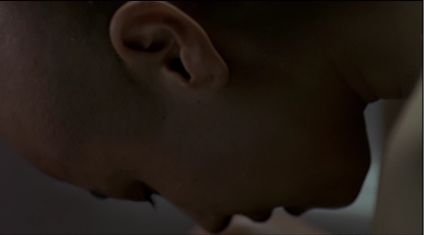
Gabal
Won Shin-yeon - 2005
Genius Products Region 1 DVD
From just reading the synopsis, The Wig may seem like one of the dopier entries, one of the too many Asian horror films about cursed objects that haunt seemingly innocent victims. In this case, a young woman, Su-Hyun, has, unknown to her, terminal leukemia, and receives the wig to cover her hair loss from chemotherapy. The wig makes Su-Hyun appear healthy and indeed, she feels revitalized. To follow are some subtle physical changes. Soon after that are nightmare visions affecting both Su-Hyun and the people closest to her.
What makes The Wig eminently worth watching is that it is a character driven film. Yes, there is the requisite shock and gore, but it is used judiciously, making the startling moments more effective. The real story of The Wig is about the fragile connection between three people, Su-Hyun, her sister who bought the wig, Ji-Hyun, and her fiance, Ki-Seok. The film is about images, how things appear, and what is revealed or hidden by images.

Art is used to explore the theme of the image. Su-Hyun uses the wig to disguise her illness. She also spends time recreating old family snapshots, replacing the shots of her sad, withdrawn self with those of a seemingly happier person. Ji-Hyun and Ki-Seok are artists. Ji-Hyun works with glass creating sculptures of people that are distorted. The fiance's artwork masks homoerotic impulses that has trouble fully acknowledging. The film makes use of a color scheme of black, primarily the wig, white, the clothing worn by the characters, and varied shades of gray.
There are allusions to Christianity, most clearly when the wigged Su-Hyun states that she feels reborn. Some Christian iconography figures into the film, primarily as part an art project Ki-Seok does on behalf of a church. What holds The Wig together is the remarkable performance by Chae Min-Seo and Su-Hyun. It may simply be the shaved head, yet Chae strongly made me think of Maria Falconetti in Passion of Joan of Arc. Chae's performance is one reason why The Wig is so much better than I would have expected. Additionally, the photography is more imaginative and precise, especially in how Chae's face is framed in the beginning of the film. The Wig is a reminder that it isn't just the story, but how you tell it, that makes a film worth watching.
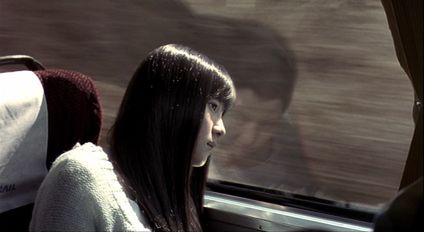
Posted by Peter Nellhaus at 07:16 AM | Comments (1)
June 24, 2008
The Nude Bomb

Clive Donner - 1980
Universal Region 1 DVD
Would you believe that The Nude Bomb is hands-down the funniest movie ever made? Would you believe that The Nude Bomb is almost as hilarious as a typical episode of Get Smart? How about a couple of random chuckles, a grin or two, before the film wears out its welcome?
My own memory of the Get Smart television series was that of a show that was inconsistently humorous and entertaining. I never bothered to see this film in its original theatrical release for that reason, as well as the less than enthused reviews that were published. While The Nude Bomb was released as a DVD to cash in on the new film with Steve Carrell, time has not enhanced this first film inspired by the television show.

The plot involves Maxwell Smart and his team of agents outwitting a villain with a bomb that causes all clothing to vaporize. The villain, Sauvage, is looking to the United Nations to pay him off in millions of dollars, or have him be the only provider of clothing for the world's people. A couple of demonstrations of the bomb's power ensue, with nude guards at Buckingham Palace, and a partially clad football team. As my viewing companion commented, this film was like watching Austin Powers without the laughs.
Don Adams was game enough to still do pratfalls at age 57. The Nude Bomb even starts with some promise during the first half hour, but the film drags on to the point where the madcap fight between clones of Maxwell Smart and Sauvage becomes uniinteresting. Having some of the female agents jockey for Smart's attention may have seemed funny on paper. Unintentionally, it makes the absence of Agent 99, played by the television series' not-so-secret weapon, Barbara Feldon, more pronounced. Also wasted is Sylvia Kristel, with Emmanuelle only a few years past, and not nude at all.
Saddest of all is that The Nude Bomb is a reminder of the steep decline of director Clive Donner. After a career peak with What's New, Pussycat?, Donner was able to make a pet project, Alfred the Great. Caught in the revolving door that was MGM at the end of the Sixties, this ambitious period film was barely released. Donner's career after that was one of a hired hand on films and television movies.
Leonard Stern, the original producer and sometime writer of the Get Smart series explained why the film went so wrong: "The Nude Bomb is something that disadvantaged all of us that were connected with Get Smart. Originally, Arne Sultan, Bill Dana, and I had an idea that we found delicious. A couturier, a foppish man with an insane fiendish desire to control the world, but not for the power and money, but for the idea that he could dress every single individual and become an international name. The Earth would be designed by him. It seemed marvelous if we could get the right flamboyant actor. It was never called The Nude Bomb, it was called The Return of Maxwell Smart. Then it got into the hands of people who simply did not want, and I can’t explain why, to duplicate the television show. They wanted to do it differently. I kept saying to them, well why did you buy it? Just leave it alone to rest in its present glory. It then became a battle of trying to maintain the integrity of Smart but not being welcome on the set. The director (Clive Donner), who was a good director, but he was used to doing intimate films was a strange choice. As was Vittorio Gassman as the flamboyant, possibly homosexual designer."

Posted by Peter Nellhaus at 12:05 AM | Comments (1)
June 22, 2008
Coffee Break

Elsa Martinelli and Dustin Hoffman in Madigan's Millions (Giorgio Gentili - 1966)
Posted by Peter Nellhaus at 12:12 AM
June 20, 2008
Frames

Loren D. Estleman - 2008
New York: Forge Books
The concept intrigued me - a murder mystery involving a film archivist. The sleuth of celluloid has the singular name of Valentino, and his self-given job title is Film Detective. As far as crime fiction goes, compared to Chandler, Cain or Leonard, this is a softboiled. The audience for this book is probably a more general audience that looks for something diverting, but not too demanding. At the very least, Frames may help educate a few more people about the need for film preservation, and the labor involved in preserving films. In light of the recent fire at Universal studios, that the key incident in the book involves a fire at MGM makes Frames more timely.
For some film scholars, this may be the literary equivalent of Raiders of the Lost Ark. In this case, Valentino has bought an old movie theater and discovers film cans containing the complete version of Erich von Stroheim's Greed. An additional discovery is a skeleton in the theater's basement. The characters include an old professor of film history who only shows up at the first and last classes of the semester, a young female law student, and an aged secretary who was once pursued by David O. Selznick. The ghost of Erich von Stroheim also makes an occasional appearance.
There's name dropping of Quentin Tarantino and Charlize Theron, a small gag involving confusion of William Castle with White Castle, and the incorporation of familiar lines from other movies. When Valentino mentions his ghostly visitor, the response is, "You see dead people". As can be expected, there are several jokes at the expense of Valentino's name as well as discussion of the silent film star. For myself, it was the discussion of how lost movies are sometimes found, as well as the processes involved in preserving and duplicating nitrate film that was of greater interest.
Estleman is reportedly working on a second Valentino mystery. After this first book, I can only guess that Valentino finds a complete version of The Magnificent Ambersons as envisioned by Orson Welles. Or maybe Valentino finds Murnau's Four Devils. If we're lucky, maybe Valentino can solve a mystery that has vexed me for years - how Norman Taurog beat Joseph von Sternberg, Lewis Milestone, Clarence Brown, and even Best Picture director Wesley Ruggles for an Academy Award.
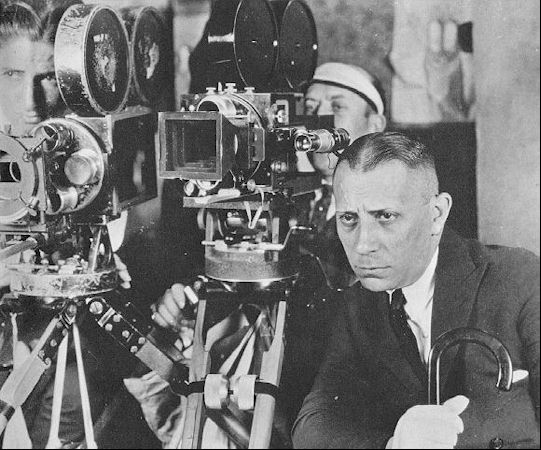
Posted by Peter Nellhaus at 07:40 AM | Comments (2)
June 17, 2008
Three
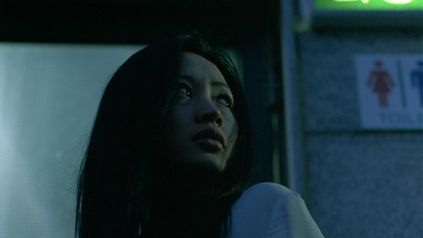
Saam Gaang/Three Extremes 2
Kim Ji-Woon, Nonzee Nimibutr and Peter Chan - 2002
Lionsgate Region 1 DVD
Today marks three years since "Coffee Coffee and more Coffee" was launched, and so . . .
An explanation of the title is in order. There are two pan-Asian horror trilogies. The second trilogy to be filmed, in 2004, was the first to be seen by Western audiences on DVD. The two trilogies are different in that this first set of stories is less graphic, and more psychological. The films also can serve as an introduction to filmmakers who will be having higher profiles among western viewers in the coming year.
At this point, Kim Ji-Woon is primarily known for A Tale of Two Sisters. Kim's newest film, The Good, the Bad and the Weird garnered attention at the last Cannes Film Festival. Kim's first film, The Quiet Family was remade by Takashi Miike as The Happiness of the Katakuris. Kim's entry here, "Memories", alternates between a husband who is missing his wife, and the wife, who is trying to remember her identity. The husband has visions of a woman who may be his wife, but he finds himself forgetting details about her. Most of the scenes of the wife, portrayed by Kim Hye-Su, are done without dialogue. The film takes place in a city of gleaming high rises, "where dreams come true", that is strangely with very few people. Like A Tale of Two Sisters, even when one thinks that the story is figured out, it isn't. There are dreams within dreams, and the narrative that may tie everything together unravels as soon it is suggested that that too is a dream.
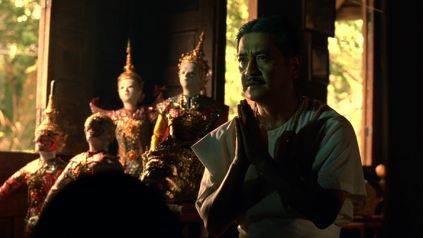
"The Wheel" is Nomzee Nimibutr's continued exploration of Thai folk legends. The story is basically about puppets that are connected with the souls of the artists who perform with them and the curses placed on those puppets. Nomzee also touches on the different hierarchies of Thai folk artists. In this case it is the status of performing artists with those who enact the folk tales with puppets. With the exception of OK Baytong, Nonzee's stories take place in previous eras. Thematically his concern is with corruption of the family unit. In "The Wheel" the patriarch's desire for stature and glory as an artist are his undoing, as his his son's anger at not having the same opportunities as the chief apprentice. Nonzee also explores the Buddhist belief about the impossibility of escaping one's karma.
Peter Chan's inclusion in a horror trilogy may seem unexpected as a writer-director. As a producer, Chan has been associated with the Pang brothers The Eye and its sequels. What Chan's entry, "Going Home" has in common with such films as Comrades: Almost a Love Story it his recurring theme of love that overcomes the most extreme obstacles. There is a continuity with the casting of frequent collaborators Leon Lai and Eric Tsang in the main roles. Christopher Doyle's cinematography conveys a severe, formal look to the film. The story is about a cop and his young son who move into a crumbling apartment building, a month away from being torn down. The only other people who seem to still live in the building are a man with his paralyzed wife and small daughter. It is never explained why the cop moves to the building. The other family is quite private, keeping to themselves. The boy and the girl have disappeared. The reclusive man is forced to reveal secrets to the cop. The attitude towards those parts of the narrative that are glossed over without explanation seems reflected in the young boy - he steps out from a place that may, or may not have, really existed, looks back, and shrugs his shoulders.
Chan, in discussing his episode stated: " I was trying to make a movie about love. And about how far you would go if you love someone. And I was using Chinese medecine as really a way of telling a story, and if you noticed, I purposely stayed away from a lot of details. I was trying to take the film to a level where you wouldn't have questions weither it's logical. I was hoping the audience would just believe in the story that I'm telling not because of Chinese medicine, but because of love."

Posted by Peter Nellhaus at 12:15 AM | Comments (1)
June 15, 2008
Coffee Break

Tobey Maguire and James Franco in Spider-Man 3 (Sam Raimi - 2007)
Posted by Peter Nellhaus at 12:48 AM
June 14, 2008
Rock Baby, Rock It

Murray Douglas Sporup - 1957
Arcanum Region 1 DVD
There's a book of oversized postcards I bought titled Lost, Lonely and Vicious. The book is a collection of posters from exploitation films, primarily from the Fifties. One the back of each postcard is a snarky blurb about the film, sometimes with actual information. One of the posters is from Rock Baby, Rock It. It's hard to forget the image of a guy playing piano with a rooster on top. As it turned out, thanks to the DVD release of this film and a little internet research, one can appreciate Rock Baby, Rock it for documenting Rosco Gordon when he performed with his rooster, Butch.
As for the film itself, there isn't a lot to say. The plot actually starts off the same way as The Young Ones. The kids are about to be evicted from their rock and roll club by some guy with a lot more money. The solution: put on a show with the biggest stars available. The stars in this case are names that would mean something to only the most devoted rock music scholar. These were regional acts that were on labels like Sun and King, back before the suits in New York fully realized there was a lot of money to be made on rock and roll. Rockabilly is well represented by Johnny Carroll, while the doo-wop highlight is The Five Stars performing "Hey, Juanita". In other words, the off stage stuff is filler between the music, which is the reason to see Rock Baby, Rock it.

While watching the film, it occurred to me that if there is ever a definitive history about independent films, scholarship should be devoted to the Fifties Drive-in circuit. Rock Baby, Rock it was financed by a Texan with money and music connections based in Dallas. According to Kay Wheeler, the Dallas teen who starred in the film, J. G. Tiger was a pseudonym for the producer who may well have acted as his own distributor. Just as there was a do-it-yourself ethos for early rock music, there's been a parallel movement, albeit much smaller, of filmmakers who made films that were primarily shown at drive-ins or in the second or third run theaters of larger cities. The films were made to make money for a less discerning audience of teenagers and young adults. I suspect that there may have been a few other films like Rock Baby, Rock It that were made on shoe string budgets with local talent, and distribution by Mom and Pop operations.
In the case of Rock Baby, Rock It, most of the film's significance is in the documentation of several musical acts of the time. While it may seem unremarkable now, it is also worth noting that this is a film about Southern white teenagers who dig music by black musicians. Yes, the black faces are restricted to the stage, but in its modest way, the film is a reminder of when early rock cut across racial lines.

Posted by Peter Nellhaus at 12:14 AM
June 11, 2008
The Tiger Blade

Seua Khaap Daap
Theeratorn Siriphunvaraporn - 2005
BCI Region 1 DVD
Throughout the DVD supplement in The Tiger Blade, there is talk about making a Thai film for the "international market". And while The Tiger Blade is a pretty good film on its own terms, it does reveal a misunderstanding of what the presumed audience outside of Thailand might be looking for if anyone bothers to see a Thai film. What Ong-bak has demonstrated most clearly is that the best hope for a theatrical run and commercial viability is in films that have lots of Muay Thai boxing and embrace their sense of being Thai. A good test case will the U.S. release of Chocolate, directed by Ong-bak's Prachya Pinkaew, about an autistic woman, skilled in martial arts.
The production team for The Tiger Blade must have spent hours watching anything that had the name of Jerry Bruckheimer or Joel Silver in the credits, plus every John Woo film from A Better Tomorrow through Face/Off. And considering that the budget was a fraction of a similar Hollywood production, the results are pretty spectacular. At its best The Tiger Blade is enjoyable purely on a visceral level with one action set piece following another. For me, the best parts of The Tiger Blade were those elements that I would associate with the sheer nuttiness that is somehow unique to Thai movies.

The operative word here is "sanook", Thai for "have fun". The film begins with the hero, Yos, interrupted while in bed with a young lady, engaged in a gun battle while wearing nothing but bath towel. Chasing one of the bad guys out to the street, Yos drops his towel to get a good shot. Yos follows one of the bad guy's cars with a steam shovel, eventually upending the bad guy's car. Even better are the scenes with the female cop, Dao, pursuing bad girl Jenjila. In a chase that ends up at a large department store, Dao picks up a skateboard to keep up with the roller skating Jenjila. Of course there is also the obligatory Muay Thai boxing scene with the two women exchanging kicks and punches. When it comes to commercial Thai films, there is nothing as fun as watching Thai martial arts between two equally skilled opponents, especially when they happen to be two hot Thai babes.
And that's the other reason to see The Tiger Blade. There are two scenes with guys opening the door to their respective bedrooms only to find several young hotties gathered on their beds. Additionally, there are the girls that populate the discos. There is so much eye candy that the point seems less about making a commercially viable Thai film than to sell the fantasy image of Thailand. Even the title object turns out to be a MacGuffin, lost in the storm of bullets and boxing. There is also a plot involving criminals and a rebel leader from one of Thailand's neighbors, robbing money to finance a revolution. None of the gravitas gets in the way of the action, not that it matters when you see actress Srungsuda Lawanprasert bursting out of a department store window or running down the side of five storey building.

Posted by Peter Nellhaus at 12:08 AM | Comments (2)
June 09, 2008
The Big Bounce

Alex March - 1969

George Armitage - 2004
both Warner Brothers Region 1 DVD
Elmore Leonard's novel, The Big Bounce, was his first foray into the contemporary crime fiction that Leonard is primarily known for now. It would be a few more novels before Leonard would fully develop the snap to be found in The Switch or City Primeval. The basic elements are there - the crooks, shnooks, and criminals with ambitions that exceed their abilities. The basic story is about a young drifter, working a migrant farm in northern Michigan, hits the field boss with a baseball bat. A kindly judge offers him work at the small resort area he owns. The drifter, Jack Ryan, falls for Nancy, the young mistress of a property owner, Ritchie, in the area. Ryan's background as a petty criminal excites Nancy, who is looking for the adrenaline rush she calls "the big bounce". Nancy and Jack dare each other to commit a variety of misdemeanors until Nancy encourages Jack to steal from Ritchie. In the meantime, Ryan's former associates are looking for ways to make in easy score, with and without Ryan.
At the time the first film version of The Big Bounce was made, Elmore Leonard was still a stranger to the New York Times best seller list. The second version seems to have been made at least partially because of the recent success of Get Shorty and Be Cool. What is interesting in comparing the two films is what was chosen in transferring the novel to film. The first version is closer to the book in spirit, and spends more time with the characters, while some Leonard's complications are pared away. The second version is more interested in the mechanics of the plot, so that some short-hand is used to substitute for character development, while more attention is spent on planning the crime. While the first film betrays Leonard in the end with an ending that is less hip than simply repugnantly amoral, the second film tries to be more complicated in its plotting with even less satisfactory results. In neither film is the title explained.

While reading Leonard's novel, I was struck by the similarity with with Pretty Poison. Both stories are about young men, outsiders with criminal pasts. They meet a young woman who they bond with initially with small acts of rebellion against parental or authority figures. Activities escalate to a point where the women goad the men towards more serious criminal activity. It is eventually made clear that the young women are psychopathic, and driven to murder primarily for the thrill of the act. There are similarities in the expression of Tuesday Weld's face when she shoots her mother to the face of Leigh Taylor-Young in the first filmed The Big Bounce. She Let Him Continue, Stephen Geller's novel that was the basis for Pretty Poison was published in 1966, with Noel Black's film released in 1968. Elmore Leonard saw The Big Bounce published in 1969, shortly after the release of the film. That the novels and subsequent films came out within this three year time span, sharing similar plot elements could be considered coincidence were it not for one conspicuous link between the two films.
The screenplay writer of Pretty Poison was Lorenzo Semple, Jr. In 1966, Semple had made his name as the main writer and story editor of the television series Batman. The first filmed version of The Big Bounce was produced by William Dozier with a screenplay by Robert Dozier. William Dozier was the producer of the Batman series, while Robert wrote some of the episodes. While I will not assume that Elmore Leonard was familiar either with Geller's novel or Black's film, I cannot imagine that the Doziers were unaware of the activity of the main Batman scribe.
The first film version of The Big Bounce may not much for a film adaptation of Elmore Leonard, but it does have a couple of points of interest. Even by Hollywood standards of the time, the nudity is generous, with heaping helpings of Leigh Taylor-Young and even Ryan O'Neal dropping trou in a couple of shots. I can go without close-ups of Van Heflin chewing his food, but it is worth noting that this his other appearance in a film based on Leonard's writings, the other appearance being the original 3:10 to Yuma. On the down side is a soundtrack by schlockmeister Mike Curb, with dopey lyrics by Guy Hemric. In Leonard's novel, he tries to show that he has some kind of pulse on the then contemporary music scene, as evident from this description of Nancy: "She changed allegiance from the Hermits to the Loving Spoonful to the Blue Magoos to the Mamas and the Papas." Robert Webber was much too old for the role as Ritchie's foreman and Ryan's rival for Nancy.
Still whatever was wrong with the 1969 version of The Big Bounce, it is still better than the 2004 version. Sebastian Gutierrez adds unneeded complications to Leonard's plot, while the film, clocking in at less than an hour and a half, still finds time to pad the action with shots of surfers. The story, moved to Hawaii, wanders even further in spirit from Leonard's novel. Perhaps had director George Armitage written the screenplay as he had for his version of Charles Willeford's funny and nasty Miami Blues, there would have been a better film. Instead, the film coasts on having laid back Owen Wilson and upright Morgan Freeman, with the stunt casting of Willie Nelson and Harry Dean Stanton, in place of anything resembling character development. Say what you will about Leigh Taylor-Young's limited acting abilities, she makes a more convincing temptress than 2004's Sara Foster. What over sixty years of film noir should have taught today's filmmakers is that the leading lady needs to not only be able to hold her own against the leading man, but she can't be forgotten when the film is over.
Maybe a second film version of The Big Bounce should not have been attempted. When asked about the worst film adaptations of his book for Time magazine, Leonard replied: "Well, it has to be The Big Bounce. When The Big Bounce came out the first time, in 1969, I said, 'This has got to be the second worst movie ever made.' I didn't know what the first one was until they remade The Big Bounce."

Posted by Peter Nellhaus at 12:22 AM | Comments (2)
June 08, 2008
Coffee Break
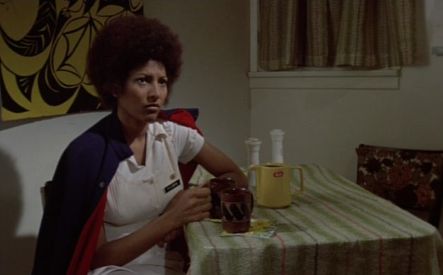
Pam Grier in Coffy (Jack Hill - 1973)
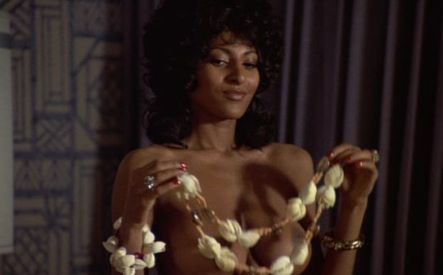
Coffy

and more Coffy
Posted by Peter Nellhaus at 12:00 AM
June 06, 2008
The Scalphunters

Sydney Pollack - 1968
MGM Region 1 DVD
The Scalphunters was one of two credited films that Sydney Pollack shot with Burt Lancaster. As a directorial assignment, the film is still worth watching to pick up some of the themes that Pollack would explore in other films, especially those that he developed. In view of Pollack's filmography, The Scalphunters could also be viewed as a practice run before making one of the films that firmly established his career, Jeremiah Johnson. Not only did Pollack demonstrate his ability with wide screen compositions in largely desert settings, but The Scalphunters contains the theme Pollack frequently returned to of the loner who who is forced to take sides for a cause in spite of personal ambivalence.
The film takes place in an unspecified part of the west, prior to the Civil War. In this case, it is Burt Lancaster as the fur trapper who is forced to exchange his pelts for runaway slave Ossie Davis, by a band of Indians. Plans to snatch back his furs are undone when the Indians are slaughtered by Telly Savalas and his gang who make money selling scalps to the U.S. government. Traveling with Savalas is Shelley Winters and her rolling bordello. Davis stumbles into the camp of Savalas and company, and his held prisoner, to be sold back into slavery. Lancaster finds himself with the sometimes conflicting goals of regaining his pelts and rescuing Davis.

The Scalphunters was the first of several films written by William Norton for the production team of Gardner-Levy-Laven. What the films have in common is the tweaking of genres, usually the western. Probably the best of their productions is The Mackenzie Break, a twist on on the World War II P.O.W. escape film, being about German soldiers in an American camp. The Scalphunters incorporates late Sixties zeitgeist in discussing racism and racial identity in the United States, as well as the notions of nature's bounty to be found in the desert's plant life. While Burt Lancaster's Joe Bass is not the enlightened hippie frontiersman of Robert Redford's Jeremiah Johnson, the similarities are easy to spot.
That The Scalphunters is more overtly political than other Gardner-Levy-Laven productions may also have to do with Burt Lancaster's control over the project. It would be interesting to know to what extent the film may have been re-written, and by whom. Lancaster was the one to choose Pollack to direct, and cast past collaborators Savalas and Winters. The Scalphunters was also consistent with the westerns Lancaster made in the Sixties and early Seventies that expressed his political beliefs. That The Scalphunters has several threads of authorship that can be discerned is in part the result of the collaborative nature of Hollywood filmmaking. In terms of Sydney Pollack's career, this may not be one of his better films, but in retrospect The Scalphunters yields clues about the types of characters and situations that would appear more clearly in future work.

Posted by Peter Nellhaus at 12:15 AM
June 04, 2008
The Machine Girl

Kataude Mashin Garu
Noboru Iguchi - 2008
Media Blasters Region 1 DVD
It is something of a critical truism that works about sex that "leave nothing to the imagination" are inferior because of pornographic expectations that seem to come with the territory. George Steiner once famously accused pornographers of subverting the "last, vital privacy" of sex by doing "our imagining for us."
Linda Williams - Hard-Core Art Film: The Contemporary Realm of the Senses
In his latest posting, Girish refers to Linda Williams' discussion of the lack of respectability in horror, melodrama and pornography. The Machine Girl has all three in spades, although the pornography is in violence so excessive that it becomes meaningless within minutes of the slaughter of a gang of school bullies. Comparisons with porno are not inappropriate considering the close-ups of flesh and gushing fluids. As has been noted before, the basic premise of a young woman with mechanical weapon in place of a missing limb was probably inspired by Rose McGowan's character in Robert Rodriguez's Planet Terror. The Japanese, as spoken by the actors in this film, has the same overly dramatic inflections of characters in Kill Bill, Vol. I. Not only is there nothing subtle about The Machine Girl, but it seems like it was designed for an audience whose knowledge of Japanese cinema was learned second-hand through Quentin Tarantino.

The basic premise is that Ami, a very athletic high school girl, has a brother, Yushie, who for an unexplained reason owed money to a school bully and his gang. Yushie and his best friend are killed by the gang, tossed out of a building to appear like suicide. The gang leader is the son of a Yakuza chief who tries to instill his "code of honor" on the son. The Yakuza leader has his hair curled up just enough to suggest devil's horns. Even more out of control is Yakuza mom, especially when she wears her steel killer driller bra. Early on, Ami tells Yushie that violence only begets more violence, and that point is literally hammered into the audience in bloody detail.
Even though the film is based on Iguchi's own screenplay, most of the characters have less depth than those found in a comic book or video game. It is probably very deliberate that when Ami shoots down ninja, school bullies and angry parents, that it is shot to resemble the point of view of someone playing a video game.
Returning to Williams' comment about pornography, the problem with The Machine Girl is that it so detailed in its presentation of gore that when the film tries to be satirical or black-humored, the desired effect is lost. Gags involving sushi or Ami's arm dipped in tempura batter end up simply being tasteless. The kind of scene in the Canadian thriller Cube, in which a character gets finely sliced and diced into multiple cubes, is disturbing. What was shocking in the earlier film becomes a cliche in the new film. Once one's expectations are sufficiently lowered, The Machine Girl is a reasonably entertaining trifle. What Iguchi perhaps unknowingly has demonstrated is that the best screen shocks, such as The Unknown, Psycho, and even the original Texas Chainsaw Massacre always left the scariest stuff to the imagination.
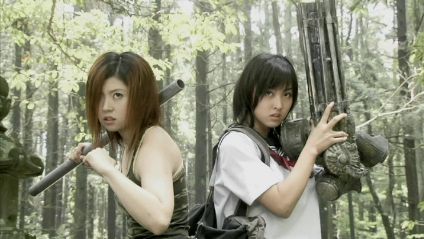
Posted by Peter Nellhaus at 12:11 AM | Comments (1)
June 02, 2008
Soft Hearts

Pusong Mamon
Joel Lamangan and Eric Quizon - 1998
Water Bearer Films DVD
Even though the Denver Public Library has a fairly amazing collection of DVDs, plus some interesting titles that I could download were I the owner of a PC, the collection is far from perfect. I may need to encourage someone there to check out Noel Vera's list of 100 great Filipino films. Because it was was one of the two Filipino titles in the DPL collection, I checked out Soft Hearts. The other Filipino film, by the way, is Cavite.
Annie, who works in a call center, longs for the seemingly unobtainable Ron. After a party for the employees, Annie as a close encounter with the extremely drunken Ron. Discovering herself pregnant, Annie goes to Ron only to discover that he has a well established relationship with Nick. Soft Hearts is the kind of resolutely "We are family" kind of film that frequently appears at film festivals. Rather than provoke any kind of discussion, Soft Heart exists primarily to preach to the choir. There is little in Soft Hearts that will be a surprise to an audience, whether it's the ex-military father whose own heart softens, the wacky aunt who dresses flamboyantly, or the boss with a secret of his own.

What I did find interesting was the ways in which Catholic ritual was used in a scene of a baby's baptism, where a confused priest initially seeks the mother of the child adopted by a gay couple. There is also a gay wedding conducted by a rogue priest. While a ladyboy appears briefly, primarily to motivate the film's one homophobic character reason to brag about beating up faggots, lesbians are mentioned but not seen. Bisexuality is beyond comprehension save for a few kisses. Unlike The Blossoming of Maximo Oliveros, the Philippines of Soft Heart is very middle-class and very comfortable. Only in one small way did Soft Hearts surprise me. In a film about Filipinos with dialogue in Tagalog and some English was a Yiddish word used in the subtitles that struck me as totally unexpected. Even a reference to borscht in a Hong Kong movie seemed less odd. I did some research and found that the Jewish population of the Philippines is about 500 people. Could a Yiddish word escape into the popular lexicon? Or as the old Disney song goes, it's a small world after all.

Posted by Peter Nellhaus at 12:09 AM
June 01, 2008
Coffee Break

Clotilde Courau and Stanislas Merhar in Almost Peaceful (Michel Deville - 2002)
Posted by Peter Nellhaus at 12:43 AM
